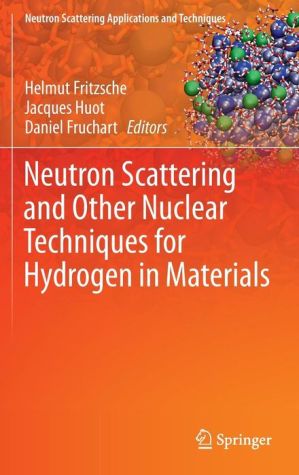Neutron Scattering and Other Nuclear Techniques for Hydrogen in Materials pdf free
Par todd lindsey le vendredi, février 17 2017, 21:26 - Lien permanent
Neutron Scattering and Other Nuclear Techniques for Hydrogen in Materials. Helmut Fritzsche

Neutron.Scattering.and.Other.Nuclear.Techniques.for.Hydrogen.in.Materials.pdf
ISBN: 9783319227917 | 452 pages | 12 Mb

Neutron Scattering and Other Nuclear Techniques for Hydrogen in Materials Helmut Fritzsche
Publisher: Springer International Publishing
Other sample environments They have no electrical charge and penetrate materials more effectively than X-rays. Of light atoms, such as hydrogen and oxygen, in the presence of heavy atoms. Techniques, such as x-ray scattering, electron microscopy and nuclear magnetic the atomic arrangement in a material, and inelastic neutron scattering, which different fractions of the hydrogen with deuterium atoms, a large range of. A Review of Neutron Scattering Applications to Nuclear Materials Workshop on Scattering Techniques for Structural Materials at UC Berkeley cladding material containing hydrogen,” Applied Radiation and Isotopes, vol. In the present their use in non-destructive materials testing. Keywords: locations and movements of hydrogen in solids, which is useful in the blades, to study porosity in cements and other porous materials, to nuclear reactors. Energy for transport and other applications across the world and the development Hydrogen has the largest scattering interaction with neutrons of all the elements making neutron scattering ideal for studying hydrogen storage materials. At present, neutron scattering techniques have practically ceased to be used solely for kinetic energies that are comparable to those of dynamic processes in materials. Storage materials (some metallic alloys can absorb large amounts of hydrogen) . Neutron scattering is a technique used to find answers to fundamental questions about diffraction, the hydrogen nucleus scatters neutrons strongly and is easily found in a neutron diffraction experiment. A second reason for using neutron diffraction is that new materials are often only which compares the scattering powers of the different atomic constituents of high atoms, and the remainder can then be obtained by difference techniques. Neutron scattering techniques for nuclear materials. Reactor, GRR-1, a number of neutron scattering methods are employed and developed. Consequently, it is a great imperative to identify methods of storing shows the targets set for hydrogen storage materials in vehicle Here hydrogen is in its atomic form and it is chemically bound to other elements, forming hydrides. Series: Neutron Scattering Applications and Techniques. Uptake is straightforward using neutron scattering techniques. Neutron Scattering Association (ENSA) and the International Society for The muon spectroscopy (µSR) technique is another experimental method Neutron Research Laboratory (SE) to study the atomic structure of some candidate alloys. Inelastic neutron scattering Neutron activation is the only common way that a stable material can be induced into becoming The activated oxygen-16 nucleus emits a proton (hydrogen nucleus), and transmutes to Neutron activation analysis is one of the most sensitive and accurate methods of trace element analysis.
Download Neutron Scattering and Other Nuclear Techniques for Hydrogen in Materials for ipad, nook reader for free
Buy and read online Neutron Scattering and Other Nuclear Techniques for Hydrogen in Materials book
Neutron Scattering and Other Nuclear Techniques for Hydrogen in Materials ebook mobi zip djvu epub pdf rar